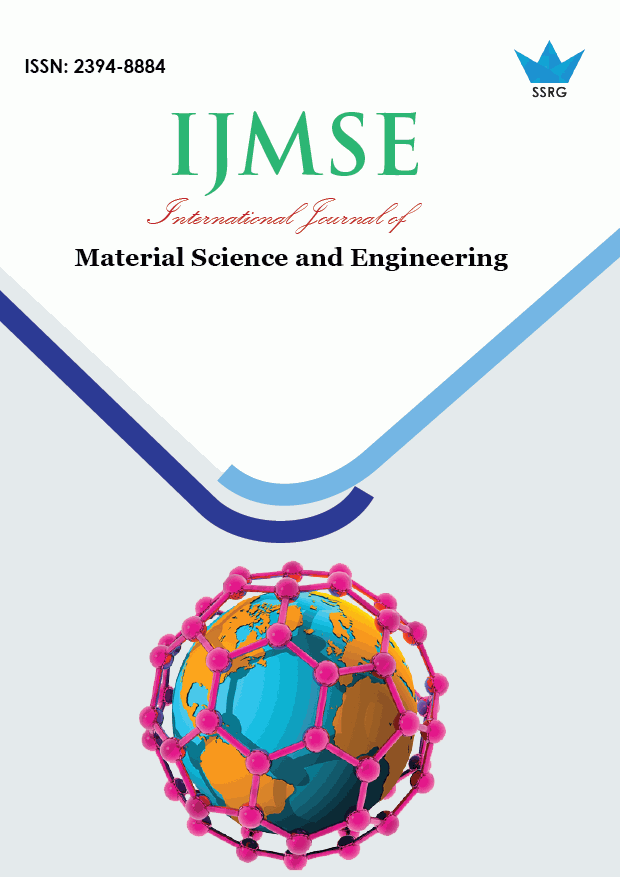Thermo-Mechanical Characterization of residue powder extracted from Rohu Fish Scale in Composite Material Development

| International Journal of Material Science and Engineering |
| © 2019 by SSRG - IJMSE Journal |
| Volume 5 Issue 2 |
| Year of Publication : 2019 |
| Authors : Gagan Bansal, Anup Kumar, V. K. Singh |
How to Cite?
Gagan Bansal, Anup Kumar, V. K. Singh, "Thermo-Mechanical Characterization of residue powder extracted from Rohu Fish Scale in Composite Material Development," SSRG International Journal of Material Science and Engineering, vol. 5, no. 2, pp. 1-6, 2019. Crossref, https://doi.org/10.14445/23948884/IJMSE-V5I2P101
Abstract:
Livestock waste is been used currently in various applications like textiles, crafting, decorations and even in biocomposite manufacturing. The reason for it is the abundance availability and compatible characteristics of the Livestock waste. Here the reviews by various literature sited has been piled up to enhance the awareness of the researchers in the area of using Livestock waste as a reinforcing material in developing various forms of composites. Properties like physical, chemical, mechanical, thermal, acoustical, morphological etc. that are been characterized by different researchers have been put together for the advancement of material development technology. In the past Importance is being given by most of the researchers to the various natural plant fibers. So for the change and the sustainable development the reviews are been formatted. The efforts are made to focus on advanced technology and uplift the use of residue powder extracted from Rohu Fish Scale as a Natural Biomaterial which is at present serve as a waste of Fish industry and to enhance the use of livestock waste in a sustainable growth of the earth and healthy environment.
Keywords:
Composites, residue powder extracted from Rohu Fish Scale, environment friendly
References:
[1] Gupta, K.M. 2006. Material Science, Second Edition, Umesh Publications, Ch-17, Other Material (wood, concrete, glass elastomer, composites etc.). 1: 428-431.
[2] May, C.A. 1988. Epoxy Resins, Chemistry and Technology, Second Ed., Marcel Dekker, New York.
[3] Nagarjuna, R.P., Smita, M. and Nayak, S.K. 2014. Synthesis and Modifications of epoxy Resins and their Composites: A Review. In Taylor and Francis, Polymer-Plastics Technology and Engineering, 53:16, 1723-1758.
[4] Fan-Long, J. and Soo-Jin, P. 2009. Thermal Stability of Tri functional Epoxy Resins Modified with Nanosized Calcium Carbonate. Bull. Korean Chem. Soc. 30: 334-338.
[5] Singh, V.K. and Gope, P.C. 2010. Silica-Styrene-Butadiene Rubber Filled Hybrid Composites. Experimental Characterization and Modeling. Journal of Reinforced Plastics and Composites. 29: 2450-2468
[6] Singh, V.K., Bansal, G., Agarwal, M. and Negi, P. 2016. Experimental Determination of Mechanical and Physical Properties of Almond Shell Particles Filled Biocomposite in Modified Epoxy Resin. Journal of Material Science & Engineering ISSN: 2169-0022 Issue 3. Volume 5.
[7] Kumar A, Bansal G, Singh V. K. “Characterization of Mechanical Strength of Epoxy Hybrid Composite Reinforced with Chicken Feather Fiber and Residue Powder Extracted from Rohu Fish Scale.” International Journal of Engineering Research & Technology (IJERT) ISSN: 2278-0181, Vol. 8 Issue 04, pp. 498-504.
[8] Narendra, R., Jiasong, J. and Yiqi, Y. 2014. Biodegradable Composites Containing Chicken Feathers as Matrix and Jute Fibers as Reinforcement. Springer Journal, DOI 10.10 07/s 10924-014-0648-9. 310-318.
[9] Mittal, D. 1997. Silica from Ash-A valuable product from waste material. General Article, Sant Longowal Institute of engineering and Technology. pp. 64-67.

 10.14445/23948884/IJMSE-V5I2P101
10.14445/23948884/IJMSE-V5I2P101